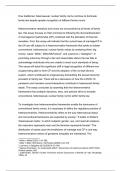How traditional, heterosexual, nuclear family norms continue to dominate
family law despite greater recognition of different family norms.
Heteronormative restraints and norms are encountered at all levels of family
law, this essay focuses on their prominence following the divorce/dissolution
of marriage/civil partnership (CP) combined with the allocation of financial
remedies. First, this essay will indicate that the current laws of marriage/CP in
the UK are still subject to a heteronormative framework that seeks to bolster
conventional, heterosexual, nuclear family values by analysing three ‘big
money’ cases: White1, Miller/McFarlane2, and Lawrence v Gallagher3. In
promoting autonomy through a fair and reasonable stance the law fails to
acknowledge individuals who are unable to reach such standards of being.
This essay will detail the significant shift in legal recognition of different-sex
couples being able to form CP and the adoption of the no-fault divorce
system, which contributed to progressively dismantling the sexual hierarchy
prevalent in family law. There will be a discussion of how the COVID-19
pandemic and mundane social interactions contribute to heterosexist family
ideals. This essay concludes by asserting that the heteronormative
frameworks that underpin decisions, laws, and policies strive to emulate
conventional, heterosexual, nuclear family norms within family law.
To investigate how heteronormative frameworks enable the dominance of
conventional family norms, it is necessary to define the regulatory practise of
heteronormativity. Heteronormativity refers to the way heterosexual status
and conventional behaviours are expected by society. 4 It builds on Butler's
'heterosexual matrix,' in which subjects' gender, sex, and need all coalesce,
the masculine represents man and the feminine represents female. 5 The
distribution of assets upon the breakdown of marriage and CP is one-way
heteronormative notions of gendered inequality are maintained. The
1
White v White [2001] 1 AC 596.
2
Miller v Miller; McFarlane v McFarlane [2006] 2 AC 618.
3
Lawrence v Gallagher [2012] EWCA Civ 394.
4
Samuel Chambers, ‘An incalculable effect’: Subversions of heteronormativity (2007) 55(3)
Political studies, 662.
5
Judith Butler, Gender Trouble: Feminism and the Subversion of Identity (2nd edn, Routledge
1999), 42.
, Matrimonial Causes Act of 1973 states that the assets of both spouses are
eligible for distribution at the court's discretion. 6 An examination of judicial
discourse will illustrate how heteronormativity manifests itself endogenously. 7
For example, in White, McFarlane/Miller and Lawrence, fundamental objective
concepts developed in judicial discourse such as equality and autonomy strive
to sustain traditional, heterosexual dichotomy of roles without any direct
confrontation of the heteronormative system.8
The 'yardstick of equality' principle was introduced in White; stating that there
should be no 'bias in favour of the money-earner and against the homemaker’,
that spouses should not be subjected to discrimination based on who the
money earner was.9 This engagement with substantive equality is viewed as a
beneficial step in enhancing women's status in law; nonetheless, the judges
refused to acknowledge social arrangements of family living that fall outside
the conventional boundaries.10 Lord Nicholls, however, remarks that the
conventional relationship of the husband working and the woman caring for
the home is not the standard anymore.11 This development is fruitless since,
further on, he reverts to an explicit heteronormative conception of the family
when he shifts from gender neutral terminology to a 'his/her' dichotomy where
the husband's work is displayed in 'his' business and 'hers' at home. 12 It
illustrates Butler's heterosexual matrix, in which Mr. White is portrayed as the
masculine financial provider and Mrs. White is portrayed as the feminine
housewife.13 Greater emphasis should have been directed on the valuable
labour that women are capable of performing both domestically and
economically, instead of the typical feminine stereotypes. 14 This lack of
6
Matrimonial Causes Act 1973, Part II.
7
Celia Kitzinger, ‘Heteronormativity in action: Reproducing the heterosexual nuclear family in
after-hours medical calls’ (2005) 52(4) Social Problems, 478.
8
Charlotte Bendall, ‘A ‘Divorce Blueprint’? The Use of Heteronormative Strategies in
Addressing Economic Inequalities on Civil Partnership Dissolution’ (2016) 32(2) Canadian
Journal of Law and Society, 280.
9
White, 615.
10
Charlotte Bendall, ‘Some are more ‘equal’ than others: heteronormativity in the post-White
era of financial remedies’ (2014) 36(3) Journal of Social Welfare and Family Law, 263.
11
White n(1).
12
White n(1).
13
Bendall n(10).
14
ibid.




